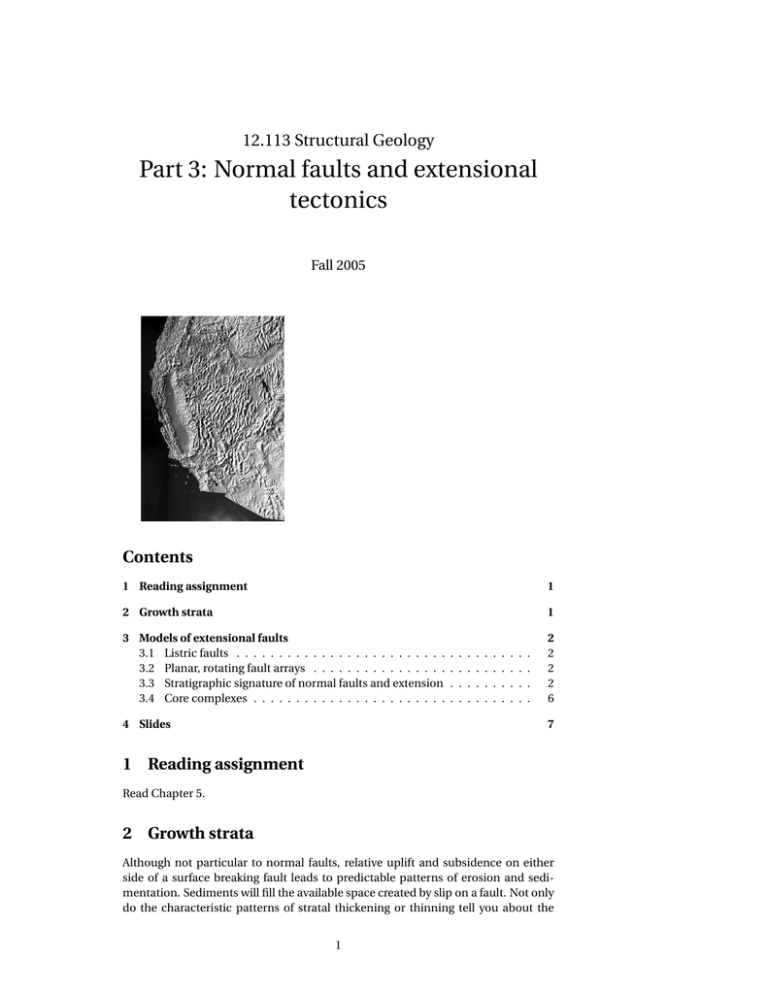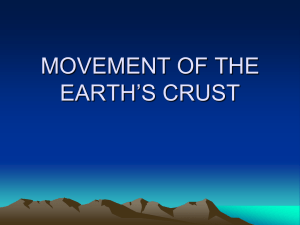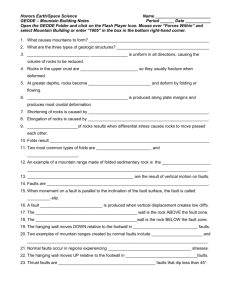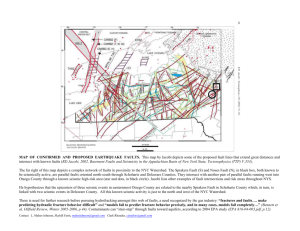Document 13518690
advertisement

12.113 Structural Geology Part 3: Normal faults and extensional tectonics Fall 2005 Contents 1 Reading assignment 1 2 Growth strata 1 3 Models of extensional faults 3.1 Listric faults . . . . . . . . . . . . . . . . . . . . . . . . . 3.2 Planar, rotating fault arrays . . . . . . . . . . . . . . . . 3.3 Stratigraphic signature of normal faults and extension 3.4 Core complexes . . . . . . . . . . . . . . . . . . . . . . . 4 Slides . . . . . . . . . . . . . . . . . . . . . . . . . . . . . . . . . . . . . . . . 2 2 2 2 6 7 1 Reading assignment Read Chapter 5. 2 Growth strata Although not particular to normal faults, relative uplift and subsidence on either side of a surface breaking fault leads to predictable patterns of erosion and sedi­ mentation. Sediments will fill the available space created by slip on a fault. Not only do the characteristic patterns of stratal thickening or thinning tell you about the 1 Figure 1: Model for a simple, planar fault style of faulting, but by dating the sediments, you can tell the age of the fault (since sediments were deposited during faulting) as well as the slip rates on the fault. 3 Models of extensional faults The simplest model of a normal fault is a planar fault that does not change its dip with depth. Such a fault does not accommodate much extension. (Figure 1) 3.1 Listric faults A listric fault is a fault which shallows with depth. Compared to a simple planar model, such a fault accommodates a considerably greater amount of extension for the same amount of slip. Characteristics of listric faults are that, in order to maintain geometric compatibility, beds in the hanging wall have to rotate and dip towards the fault. Commonly, listric faults involve a number of en echelon faults that sole into a low­angle master detachment. (Figure 2) 3.2 Planar, rotating fault arrays An array of parallel, normal faults slipping on a sub­horizontal detachment will ro­ tate with fault slip, much like books on a book shelf. As they rotate, the dip of the faults will get shallower, and the beds between the faults will also rotate. Again, the amount of extension can be calculated for a given angle between beds and the fault, and the total amount of slip on the fault. Sometimes, normal fault systems are, in fact, best described as a combination of listric faults with rotating, planar faults bounding rotating blocks in the hanging wall. The "master fault" – called a detachment fault is a listric fault, with a set of rotating planar faults in its hanging­wall or upper plate. The steep part of the de­ tachment is sometimes called the break­away fault. Figure 4 3.3 Stratigraphic signature of normal faults and extension If, prior to extensional faulting, stratigraphy was undeformed, then the characteris­ tic of normal faulting is that younger rocks will be juxtaposed over older rocks, but 2 Figure 2: Geometry of listric normal faults. The bottom figure shows the geometric relations for calculating the amount of extension, given the angle between beds and the fault, and the total fault slip 3 Figure 3: A system of rotating, planar faults. The bottom figure shows how this ge­ ometry compares to simple listric normal faults in terms of the amount of extension that can be produced 4 Figure 4: Listric fault, with rotating upper plate blocks and breakaway fault Figure 5: Stratigraphic signature of extensional tectonics where low angle faults are present 5 Figure 6: Model for core complex formation along a low angle detachment with "missing section" at the fault. Particularly where the normal faults are low­angle, this relationship is often mis­ interpreted. Prior to the recognition that low angle normal faults are widespread features of the extended crust, they were often mapped as thrusts (which makes no sense) or unconformities. Where low angle faults are common, a "stratigraphic sec­ tion" will show many apparent gaps. Figure 5 3.4 Core complexes A common feature of highly extended terrains is that large amounts of extension on relatively low angle normal faults juxtaposes rocks of high metamorphic grade against unmetamorphosed rocks and even surficial deposits. The exposure of high grade rocks typically domal, or antiformal geometry, with normal faults completely bounding the high­grade rocks. Rocks in the immediate footwall of the bounding normal faults show a characteristic series of fabrics: since rocks are brought up from depth, fabrics reflecting progressively colder and more brittle deformational envi­ ronments are superimposed upon one another. So, walking from the interior of the core complex out towards the low­grade upper plate rocks ductile fabrics and my­ lonites will be overprinted by brittle­ductile transitional fabrics, which themselves are often overprinted by thick gouge and breccia and then a discrete, brittle fault. The conceptual model of core complexes – high grade rocks brought to the sur­ face along low angle detachments has some important implications for how exten­ sion is accommodated in the lower crust or mantle. In figure 6, large amounts of slip on a detachment obviously creates a great deal of "space" in the lower crust. The question then is: does the detachment offset the Moho, and accommodation is then 6 Figure 7: Two models for accommodating large amounts of extension in the upper crust. From Block and Royden 1984 taken up by flow of mantle rocks. Or does the detachment sole into the middle or lower crust, with lower crustal flow solving the space problem. See figure 7. 4 Slides 7 Figure 8: Rocks above a low angle detachment are broken up by normal faults that sole into the main detachment. The yellow unit is the same in all the outcrops 8 Figure 9: Range scale tilted normal fault block 9 Figure 10: Series of planar rotated normal faults. Scale is about 2 meters from top to bottom of the slide. This faulting has accommodated about 60% extension. 10 Figure 11: Listric fault 11 Figure 12: Listric fault merging into a detachment surface at the feet of geologist. Figure 13: Low angle normal fault. Some people still don’t believe these are real. 12 Figure 14: Low angle normal fault; rocks in the hanging wall of the fault are late Quaternary. There are folks who believe that low angle faults do exist, but believe they were rotated from an initially steep attitude. This a more reasonable attitude than total denial, to be sure. Figure 15: The Whipple mountains are one of the archetypical core complexes of the western U.S. extensional provinces. This is a cross­section from the work of Lister and Davis. Note the multiple rotations. 13 Figure 16: A view looking east at the northern Panamint Rnage: lower plate high grade rocks to the left, upper plate rocks to the right. The surface sloping to the left in the slide is the detachment fault surface. 14 Figure 17: View to the east along the Whipple detachment. Dark rocks are Tertiary aged sediments and volcanic rocks in tilted and rotated blocks. Pale rocks are the lower plate mylonites 15 Figure 18: Spot the low angle detachment 16 Figure 19: Detachment surface in the Clark mountains, California 17 Figure 20: High grade fabrics representative of extensional strain at deep crustal lev­ els. These rocks are lower plate rocks below a detachment in Death Valley. 18 Figure 21: High grade fabrics with lower grade (i.e. progressively more brittle) defor­ mation overprinted on them. 19 Figure 22: High grade extensional shear fabrics Figure 23: C/S fabric, ductile deformation 20 Figure 24: Low grade (brittle) gouge and breccia; lower plate of a detachment fault. 21






